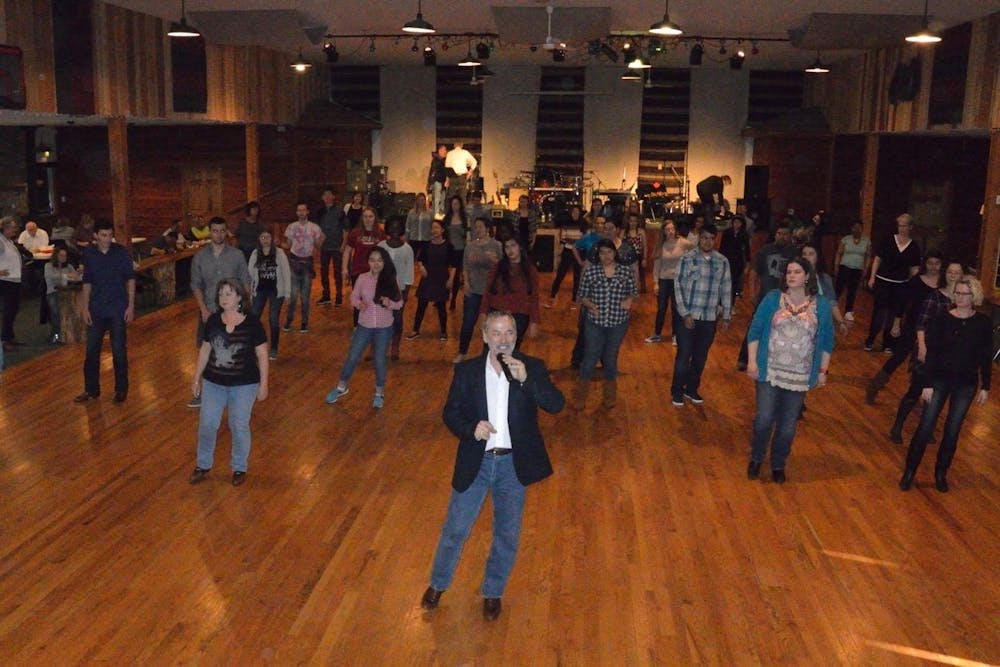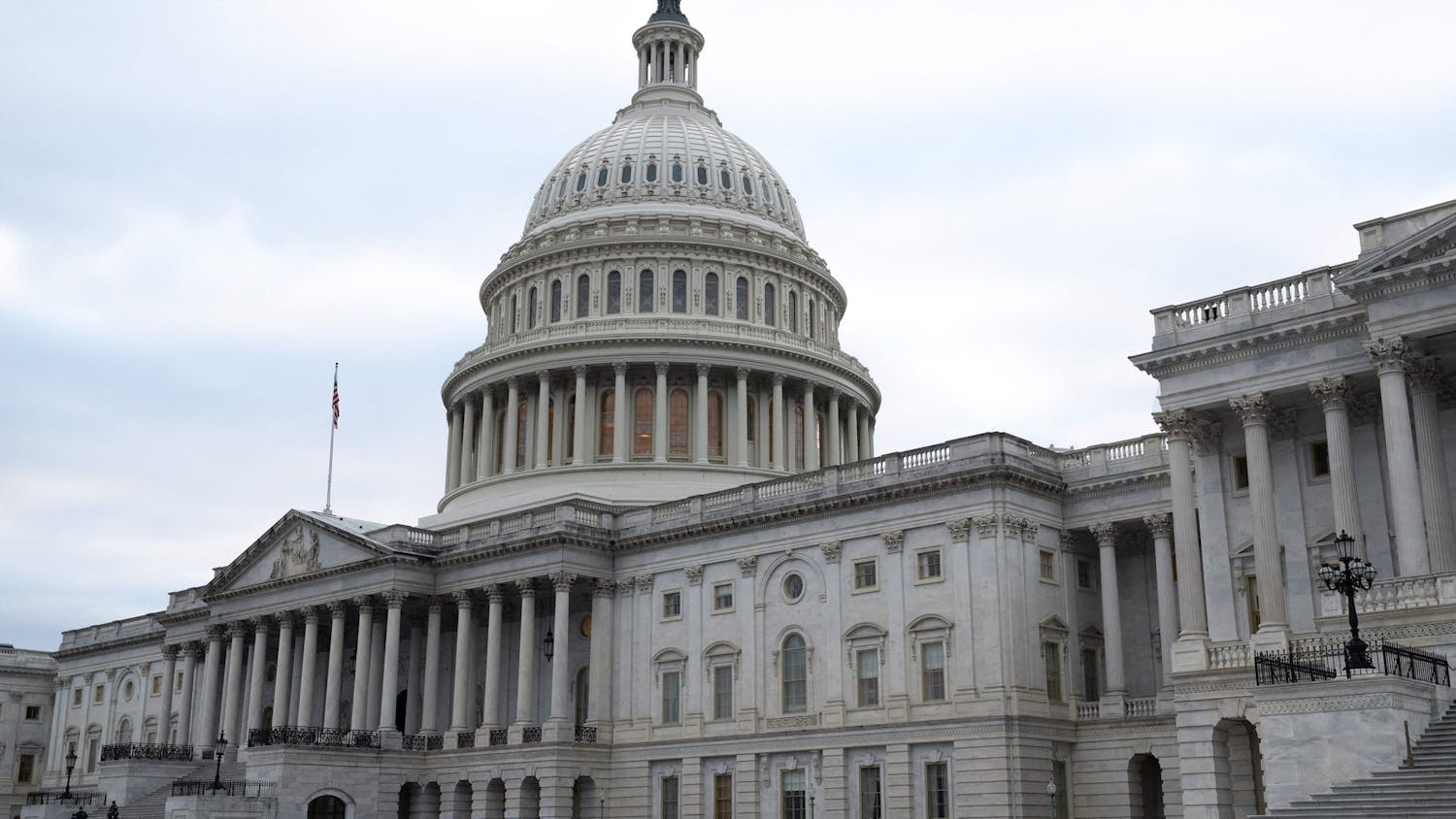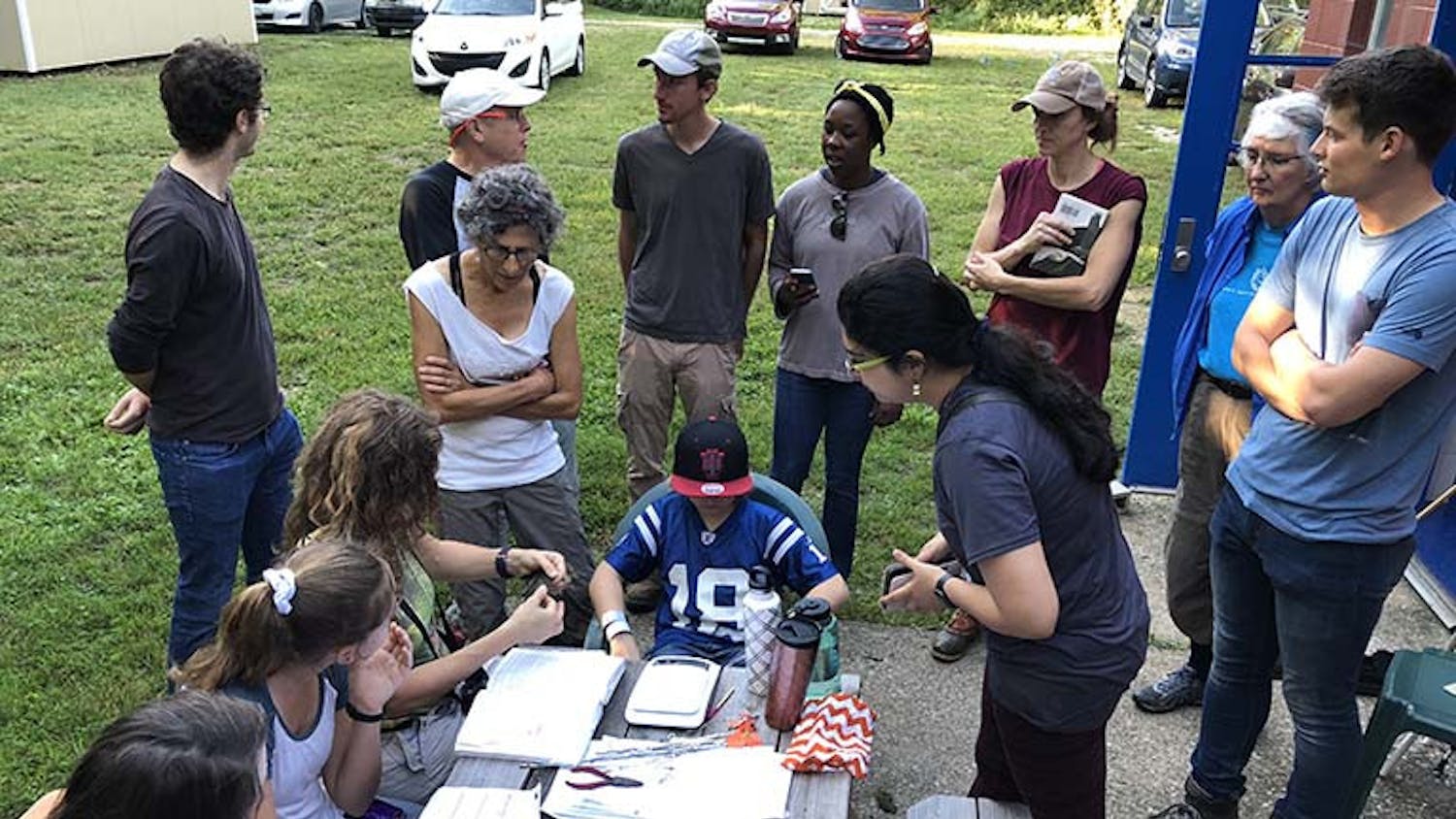Instructor Billy Crase played all of the best hits at the Mike’s Dance Barn line dancing session on Nov. 22. It was the last night before the dance hall would close its doors for the second time due to the COVID-19 pandemic.
The 13-person crowd started out the night with “Dance Monkey” and grapevined, toe-tapped and shuffled their way through the classics such as “Day of the Dead” and “Jose Cuervo.”
“What about the hokey pokey?” one of the dancers yelled across the dance floor to Billy, who was manning the sound booth.
After the first few notes blasted over the speakers, about six people rushed back to the floor to step to the easiest dance they had ever done in the dance barn.
This sudden excitement to participate in all dances came after Carla Willis-Crase, dance instructor and Billy’s wife, announced she and Billy were canceling Monday line dancing for at least the next two months.
When Carla made her announcement, she made sure to not mention masks or social distancing. She didn’t want to upset certain members of the crowd.
“Please take care of yourself,” she said. “We want to see you back here in January.”
The dance hall had been open since August 31. Owner Mike Robertson reopened the space just for Monday line dance sessions and some private events after two months of closed doors due to the COVID-19 pandemic.
Brown County was averaging about one new COVID-19 case per day when the dance hall reopened in late August. The county did not see an increase in cases until November, when there was a spike of 21 cases on Nov. 14. About a week later, Carla and Billy decided to cancel lessons, which was the only event still taking place each week.
The holidays were coming up and the couple knew many of their regulars would not stick to small gatherings like the state and Centers for Disease Control and Prevention had encouraged.
They decided to postpone lessons, Carla explained to the crowd of dancers, because the state determined the number of COVID-19 cases in Brown County were spiking. They hoped to return following the holiday season, but Carla, Billy and Mike knew that may not be the case.
“So, I guess this means that we’re not going to have a Christmas dance?” one of the dancers asked.
The dance hall had been operating differently than before the COVID-19 pandemic. The tables on the sides had been spaced out to discourage social interaction and little tears of blue painters tape had been placed six feet apart on the dance floor to indicate where people could safely stand. About half of the regulars had been missing from weekly sessions, either because they didn’t want to wear a mask or because others weren’t wearing theirs.
But the Monday night sessions had remained a constant.
Most people stuck around for goodbyes after the final 2 1/2 hour session.
“You guys take care of yourselves,” one dancer said to Carla, tears in her eyes.
The first time Mike’s Dance Barn closed its doors was back in March, right before Indiana issued a stay-at-home order.
When the dance hall first opened in Nashville, Indiana, 22 years ago, it was a place where people of all ages would congregate on a packed dance floor to line dance and listen to great live music. As the popularity of line dancing decreased and the average age of attendees increased, Mike’s became a place for older dancers and close friends to come in groups, spread out and dance, typically to prerecorded music.
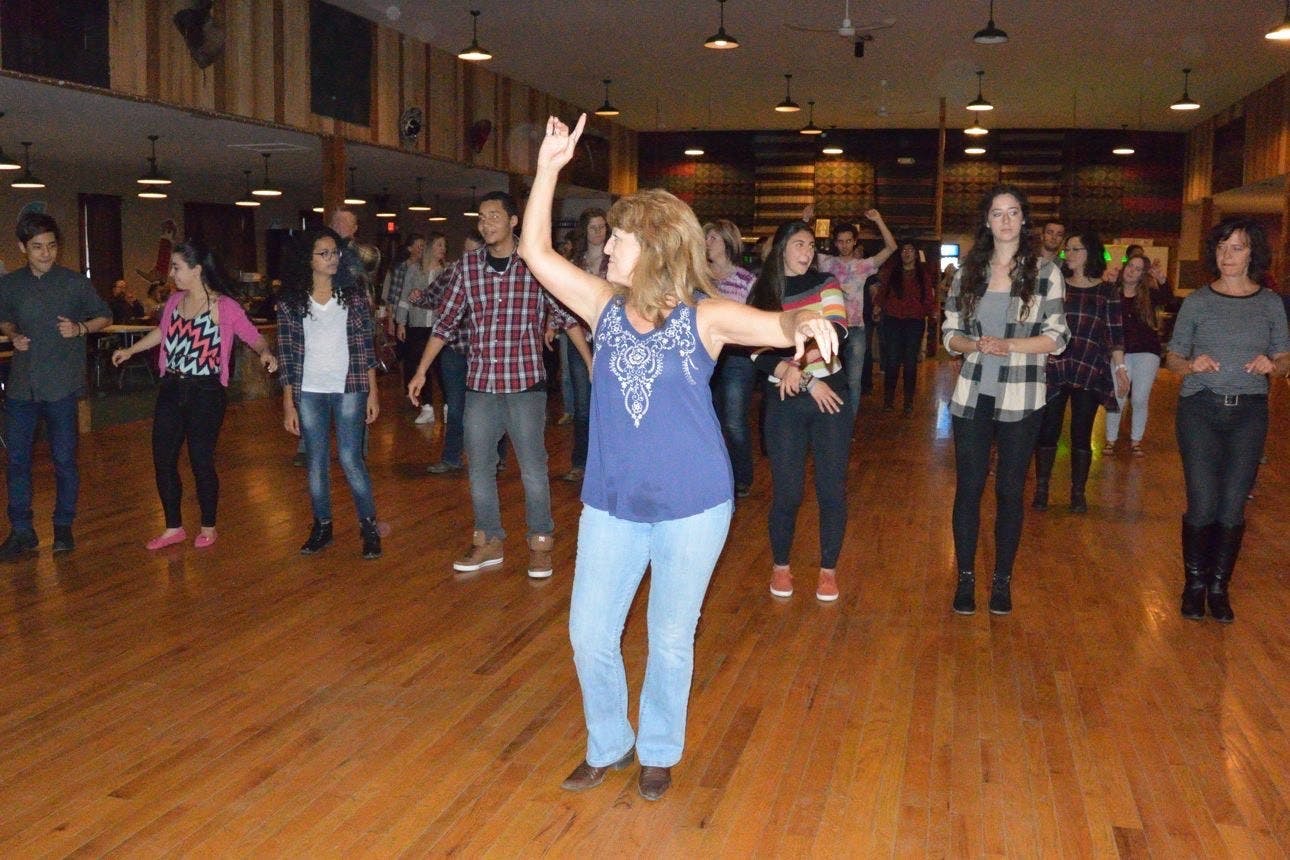
On Monday nights, Mike brought in Billy and Carla to play music, teach and lead dances. Billy acted as the lead instructor and DJ while Carla mainly coasted around the dancefloor, sometimes stepping in front to show people how it was done in her high-heeled boots.
They’re both the kind of confident dancers who add flairs and heel taps in between dance steps. Sometimes during dances that everyone knew, Carla would approach her husband and they would instantly switch into a partnered version of the line dance.
Many of the dancers know how to carry on even without the dynamic duo in front. Some of them have been coming to the dance barn or line dancing for as long as Billy has — 20 years — if not longer.
Up until the first closure in March, Mike’s was hosting two line-dancing sessions with 35 people attending each night every week, about one sorority or fraternity formal a month and one wedding every other month. After the closure, the money made from those consistent events vanished.
Still, Mike managed to make the monthly payments of $2,300 by picking up odd jobs and even using some of his Social Security funds. Mike said he didn’t build the barn to become a successful businessman. He built it to bring live music and dancing to the community.
The dancers who attend Mike’s Monday sessions are an average of 60 years old, Billy said. Some of them have been dancing for almost 30 years, the majority of that time spent in Mike’s or neighboring dance halls. Others have only been around for a few years, many of them brought in by dance hall veterans.
They aren’t all close friends. A dancer typically has a small group they sit with in an unofficial assigned seat in the area surrounding the dance floor. However, they all gather in the same space at least once a week to do something they enjoy.
They supported each other through many crises, such as when Kimberly Koons fought breast cancer or when Bobbie Richardson’s husband died in July. They also celebrated together during birthdays and anniversaries. Two dancers, Linda and Conan Gill, became so close that they later got married and invited about 80 dancers from Mike's to the wedding. Others simply have enjoyed the opportunity to exercise and talk to other people, especially in the last three months.
Generally, the dancers have cohabitated in the space without quarreling or kicking up drama. But many of them have different opinions and comfort levels regarding Mike’s COVID-19 rules and restrictions.
Billy and Carla knew it was a stretch opening the lessons back up when they did because of the COVID-19 pandemic. Many other performance and social spaces were still closed to slow the curve of the rising COVID-19 cases.
So, on Aug. 31, the first night the dance barn reopened, the instructors took steps to make sure it was going to be a safe gathering.
Carla had to hold back the usual hugs and side-pats as she greeted her line-dancing students. She asked her catch-up questions from at least 6 feet away and presented the group of about 25 dancers with a waiver that stated everyone would need to attempt to follow the state and local COVID-19 guidelines.
Billy and Carla made sure the document was posted multiple times on the Mike’s Dance Barn Facebook page leading up to the first night back, so all of the regulars would see it and know the rules.
According to the paper, dancers and staff were required to wear a mask as they walked in and out of the front doors and when they walked around the exterior of the dance floor.
They were not required to wear them on the dance floor because the 25 dancers — mainly regulars with sometimes four guests — attending can easily spread out about 6 feet apart. They were recommended to wear a mask when they sat at their tables.
Even though the rules were available to people before they walked in, some people were still upset when they were handed the document.
About three people later called Billy and Carla after the first night. They said they wouldn’t come back if they had to wear a mask.
Others left after they saw how many people refused to wear masks on the dance floor.
Sharon Snodgress, 63, walked out the first night after sitting down for three minutes at her table in the back right corner. She thought she would be able to make it through the night. But when her tablemates sat down and removed their masks, she felt uncomfortable.
Sharon never set foot on the dance floor. She hasn’t returned since.
These tiffs, walkouts and discussions endured throughout the almost three months Mike’s was open. Billy and Carla had to remind the dancers about the mask requirement a few times in their general announcements at the beginning of Monday nights.
One night, a group of people sat out from dancing about the entire two hours in silent protest of the mask requirement.
Other dancers such as Kimberly Maus, 56, didn’t seem to notice. New dancers and sometimes older ones come in, sit out and watch all the time, she said. But Billy and Carla said the room felt different that night, like the energy had been sucked out.
On the one night Carla took every dancer’s temperature, one person refused.
Conan Gill, 69, overheard dancers talking at a lesson in November about how they didn’t feel it was necessary to wear masks. He heard others, both regulars and guests, saying wearing them made it harder to breathe or it made them hot.
He and his wife Linda went one more night, saw fewer people wearing masks and socially distancing and decided it was better to stay home.
Another night, Billy reminded the crowd that they needed to wear their masks in and out of the building. Afterward, one man approached Carla.
“You know that’s unconstitutional, right?” she recalled him asking.
Other dancers and staff have different opinions about Mike’s COVID-19 rules, but pretty much follow the rules without complaint.
Most of them don’t mind wearing masks or asking other people to put theirs on. Susan Binder, 66, said she had to subtly encourage and occasionally argue with a friend who didn’t feel the need to wear a mask. Kimberly Koons, who finished chemotherapy for breast cancer this year, said she isn’t scared of the virus, but she wore a mask and wasn’t afraid to tell people to put one on.
Some dancers, such as Linda and Conan, were a little more cautious than those just sticking to Mike’s rules. They waited three weeks to return to the dance barn after it opened and were one of the few couples who tried to wear their masks every time they danced.
Bobbie started wearing her mask more at the beginning of November because she had grown more anxious about the virus as she spent more time at Mike’s and the cases in Brown County grew. Pat Boyer, 88, and her husband Bob, 87, took their temperature twice a day in addition to wearing masks on the dance floor when they didn’t make it too hard to breathe. Bob said he sometimes liked to wear it when his face got cold.
Other people followed the rules but only to a certain extent. Jonathan Myers, 68, said he thinks the general public should have been told to wear masks earlier and that he believes the virus is serious. However, he said he doesn’t like all the restrictions set by the state for COVID-19.
If he had to wear a mask on the dance floor, he wouldn’t come back.
Brown County was not a hotspot for COVID-19 this summer. As of Aug. 31, two people from the county had died due to the virus. Now, eight people from Brown County have died from COVID-19 and 493 have tested positive. Seven other Indiana counties have fewer deaths and six counties have fewer COVID-19 cases.
Many people in the county did not know someone who had contracted COVID-19 when Mike’s reopened the first time, much less someone who had died from it.
Billy said he wonders if people would have taken the mask requirement more seriously or hunkered down earlier had there been a higher death rate.
Billy, an advocate of the mask mandate, set some boundaries for himself that were more stringent than those at Mike’s.
When he was in the music booth, he asked that people put their mask on before they walked up and requested a song. Carla also requested that people put up their masks and stand farther away when talking to her. But she had many dancers stand too close, forcing her to step back.
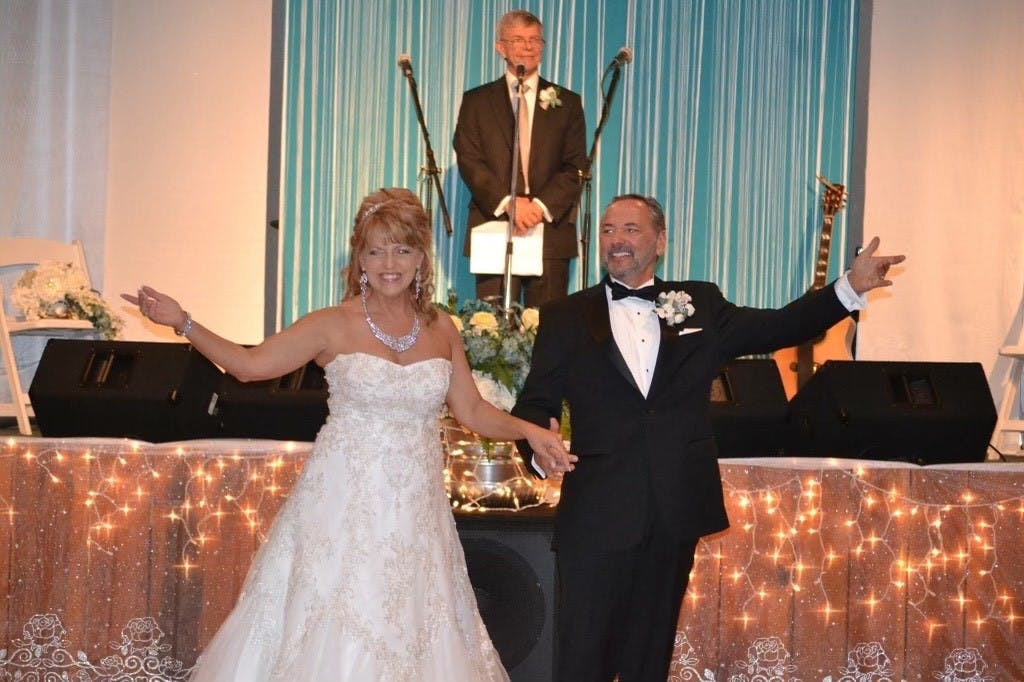
Billy and Carla tried and for the most part succeeded in keeping their opinions to themselves at the dance barn regarding masks and COVID-19 rules. They didn’t want to upset some of their closest friends, people who attended their wedding, who don’t fully agree with them.
So, when Carla announced that people should stay safe over the holidays, she avoided mentioning masks. Then, when the man told her making him wear a mask was unconstitutional, she didn’t tell him he was wrong. Instead she implied she didn’t agree with him and responded politely to his comment.
“I’d like to think that he got the notion that, ‘Hey, that’s a kooky thing to say,’” Billy said about how Carla responded to the comment. “But what do I know?”
When they walked through the doors to the gravel parking lot on Nov. 22, Billy and Carla wondered if the dance hall would ever be the same again after this final lesson of the year.
In the last 22 years since Mike opened the dance hall people had danced, celebrated birthdays, met their spouses and gotten married in the space. Billy and Carla had gotten married there almost exactly five years ago with about 75 Mike's line dancers in attendance.
The last time the doors had closed in March, it had still felt like they might return. Now, they weren’t as sure.
They have an unofficial reopen date of Jan. 10, but they have to get over many obstacles before they can open again. The COVID-19 pandemic could get worse, postponing their reopening. Mike could run into more trouble with paying the bills, especially with the lack of financial support coming from the federal government.
They also wondered, even if they overcome these obstacles and return in January, if they would see all of their regulars pour through the doors. Many of them are older and a few of them still argue about wearing masks. Carla told them to stay safe during the holidays, but she wasn’t sure they would heed her warning.
It didn’t take long after that night for Billy and Carla to realize they had made the right decision in canceling lessons for the rest of the year.
On Nov. 27, two individuals who had been in attendance at the last dance session tested positive for COVID-19. Three days later, Billy and Carla tested positive. They know they didn't contract COVID-19 from someone at the barn.
Still, on the day of the last dance session, it was hard to let go of the almost normalcy the line dancing nights had given them, even with the tiffs over COVID-19 rules.
“Is this it?” Billy thought to himself as he walked through the doors out into the gravel parking lot. “Is this the last time that we do this?”

